Han Liu
Johns Hopkins University
On Flow Matching KL Divergence
Nov 07, 2025Abstract:We derive a deterministic, non-asymptotic upper bound on the Kullback-Leibler (KL) divergence of the flow-matching distribution approximation. In particular, if the $L_2$ flow-matching loss is bounded by $\epsilon^2 > 0$, then the KL divergence between the true data distribution and the estimated distribution is bounded by $A_1 \epsilon + A_2 \epsilon^2$. Here, the constants $A_1$ and $A_2$ depend only on the regularities of the data and velocity fields. Consequently, this bound implies statistical convergence rates of Flow Matching Transformers under the Total Variation (TV) distance. We show that, flow matching achieves nearly minimax-optimal efficiency in estimating smooth distributions. Our results make the statistical efficiency of flow matching comparable to that of diffusion models under the TV distance. Numerical studies on synthetic and learned velocities corroborate our theory.
Video-LMM Post-Training: A Deep Dive into Video Reasoning with Large Multimodal Models
Oct 06, 2025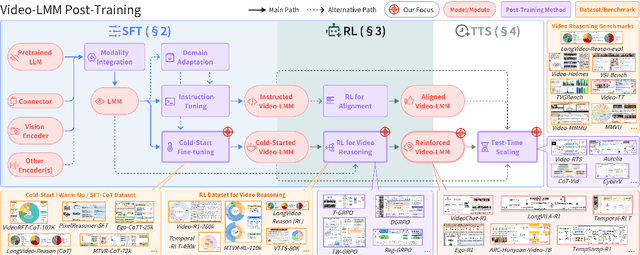
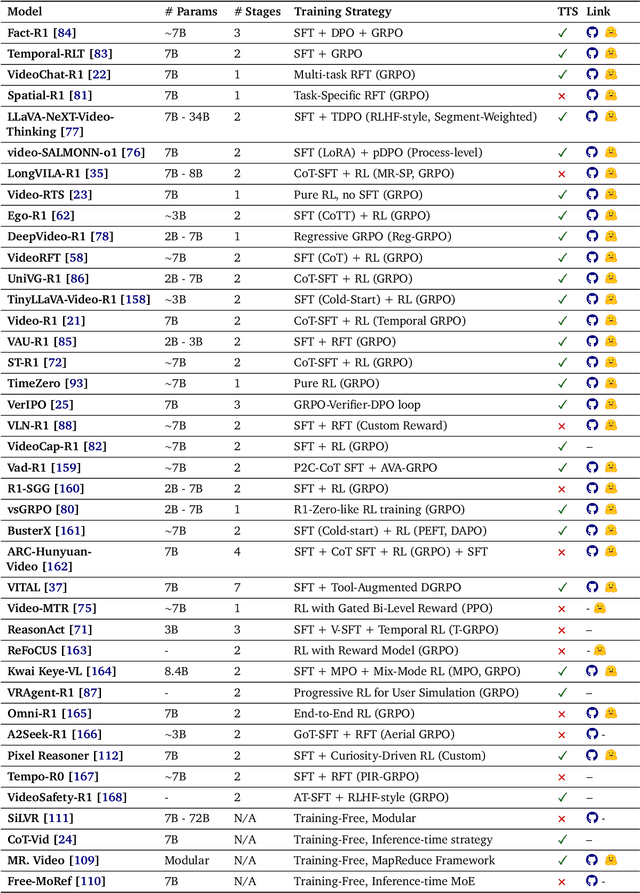
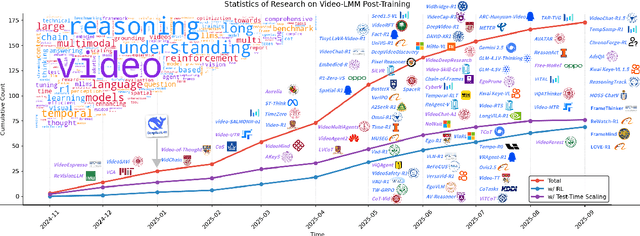
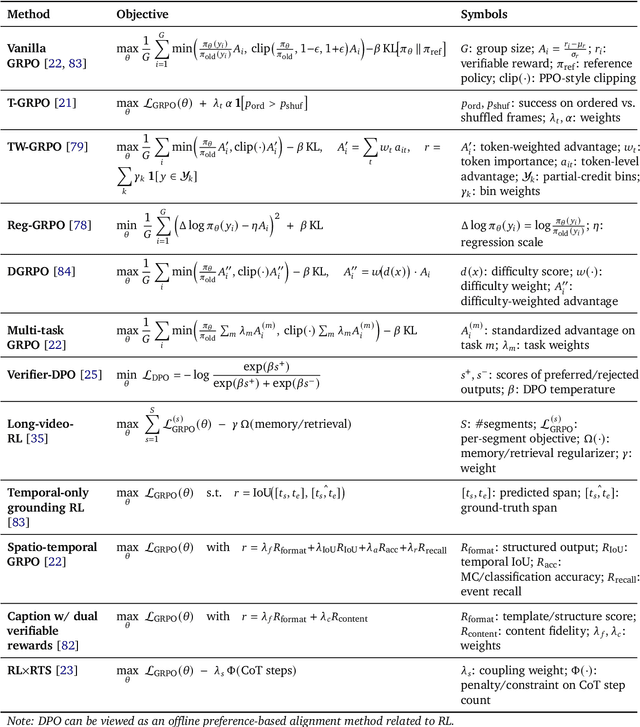
Abstract:Video understanding represents the most challenging frontier in computer vision, requiring models to reason about complex spatiotemporal relationships, long-term dependencies, and multimodal evidence. The recent emergence of Video-Large Multimodal Models (Video-LMMs), which integrate visual encoders with powerful decoder-based language models, has demonstrated remarkable capabilities in video understanding tasks. However, the critical phase that transforms these models from basic perception systems into sophisticated reasoning engines, post-training, remains fragmented across the literature. This survey provides the first comprehensive examination of post-training methodologies for Video-LMMs, encompassing three fundamental pillars: supervised fine-tuning (SFT) with chain-of-thought, reinforcement learning (RL) from verifiable objectives, and test-time scaling (TTS) through enhanced inference computation. We present a structured taxonomy that clarifies the roles, interconnections, and video-specific adaptations of these techniques, addressing unique challenges such as temporal localization, spatiotemporal grounding, long video efficiency, and multimodal evidence integration. Through systematic analysis of representative methods, we synthesize key design principles, insights, and evaluation protocols while identifying critical open challenges in reward design, scalability, and cost-performance optimization. We further curate essential benchmarks, datasets, and metrics to facilitate rigorous assessment of post-training effectiveness. This survey aims to provide researchers and practitioners with a unified framework for advancing Video-LMM capabilities. Additional resources and updates are maintained at: https://github.com/yunlong10/Awesome-Video-LMM-Post-Training
On Structured State-Space Duality
Oct 06, 2025
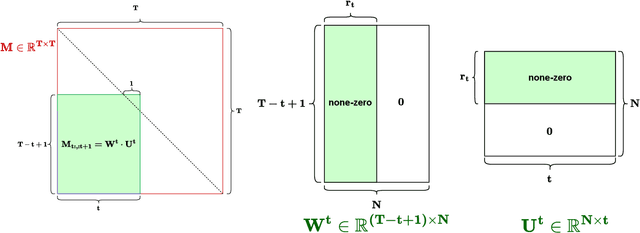
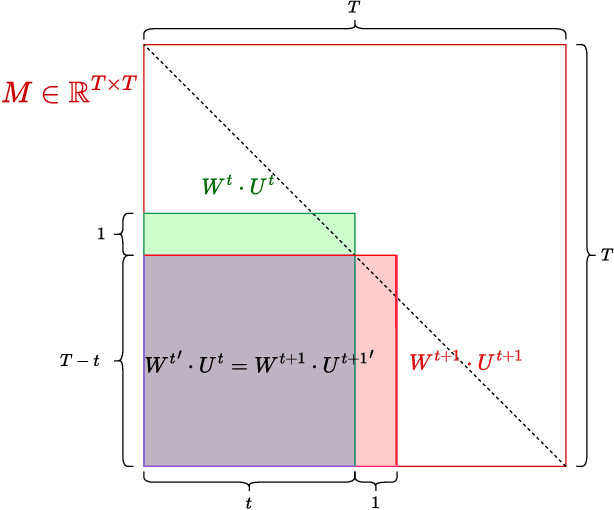
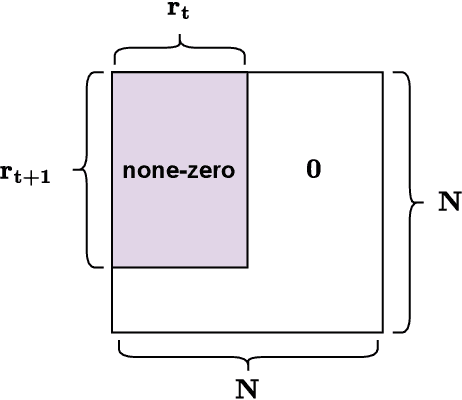
Abstract:Structured State-Space Duality (SSD) [Dao & Gu, ICML 2024] is an equivalence between a simple Structured State-Space Model (SSM) and a masked attention mechanism. In particular, a state-space model with a scalar-times-identity state matrix is equivalent to a masked self-attention with a $1$-semiseparable causal mask. Consequently, the same sequence transformation (model) has two algorithmic realizations: as a linear-time $O(T)$ recurrence or as a quadratic-time $O(T^2)$ attention. In this note, we formalize and generalize this duality: (i) we extend SSD from the scalar-identity case to general diagonal SSMs (diagonal state matrices); (ii) we show that these diagonal SSMs match the scalar case's training complexity lower bounds while supporting richer dynamics; (iii) we establish a necessary and sufficient condition under which an SSM is equivalent to $1$-semiseparable masked attention; and (iv) we show that such duality fails to extend to standard softmax attention due to rank explosion. Together, these results tighten bridge between recurrent SSMs and Transformers, and widen the design space for expressive yet efficient sequence models.
AdvEvo-MARL: Shaping Internalized Safety through Adversarial Co-Evolution in Multi-Agent Reinforcement Learning
Oct 02, 2025Abstract:LLM-based multi-agent systems excel at planning, tool use, and role coordination, but their openness and interaction complexity also expose them to jailbreak, prompt-injection, and adversarial collaboration. Existing defenses fall into two lines: (i) self-verification that asks each agent to pre-filter unsafe instructions before execution, and (ii) external guard modules that police behaviors. The former often underperforms because a standalone agent lacks sufficient capacity to detect cross-agent unsafe chains and delegation-induced risks; the latter increases system overhead and creates a single-point-of-failure-once compromised, system-wide safety collapses, and adding more guards worsens cost and complexity. To solve these challenges, we propose AdvEvo-MARL, a co-evolutionary multi-agent reinforcement learning framework that internalizes safety into task agents. Rather than relying on external guards, AdvEvo-MARL jointly optimizes attackers (which synthesize evolving jailbreak prompts) and defenders (task agents trained to both accomplish their duties and resist attacks) in adversarial learning environments. To stabilize learning and foster cooperation, we introduce a public baseline for advantage estimation: agents within the same functional group share a group-level mean-return baseline, enabling lower-variance updates and stronger intra-group coordination. Across representative attack scenarios, AdvEvo-MARL consistently keeps attack-success rate (ASR) below 20%, whereas baselines reach up to 38.33%, while preserving-and sometimes improving-task accuracy (up to +3.67% on reasoning tasks). These results show that safety and utility can be jointly improved without relying on extra guard agents or added system overhead.
A Theoretical Analysis of Discrete Flow Matching Generative Models
Sep 26, 2025Abstract:We provide a theoretical analysis for end-to-end training Discrete Flow Matching (DFM) generative models. DFM is a promising discrete generative modeling framework that learns the underlying generative dynamics by training a neural network to approximate the transformative velocity field. Our analysis establishes a clear chain of guarantees by decomposing the final distribution estimation error. We first prove that the total variation distance between the generated and target distributions is controlled by the risk of the learned velocity field. We then bound this risk by analyzing its two primary sources: (i) Approximation Error, where we quantify the capacity of the Transformer architecture to represent the true velocity, and (ii) Estimation Error, where we derive statistical convergence rates that bound the error from training on a finite dataset. By composing these results, we provide the first formal proof that the distribution generated by a trained DFM model provably converges to the true data distribution as the training set size increases.
LeVR: A Modular VR Teleoperation Framework for Imitation Learning in Dexterous Manipulation
Sep 17, 2025



Abstract:We introduce LeVR, a modular software framework designed to bridge two critical gaps in robotic imitation learning. First, it provides robust and intuitive virtual reality (VR) teleoperation for data collection using robot arms paired with dexterous hands, addressing a common limitation in existing systems. Second, it natively integrates with the powerful LeRobot imitation learning (IL) framework, enabling the use of VR-based teleoperation data and streamlining the demonstration collection process. To demonstrate LeVR, we release LeFranX, an open-source implementation for the Franka FER arm and RobotEra XHand, two widely used research platforms. LeFranX delivers a seamless, end-to-end workflow from data collection to real-world policy deployment. We validate our system by collecting a public dataset of 100 expert demonstrations and use it to successfully fine-tune state-of-the-art visuomotor policies. We provide our open-source framework, implementation, and dataset to accelerate IL research for the robotics community.
In-Context Algorithm Emulation in Fixed-Weight Transformers
Aug 24, 2025

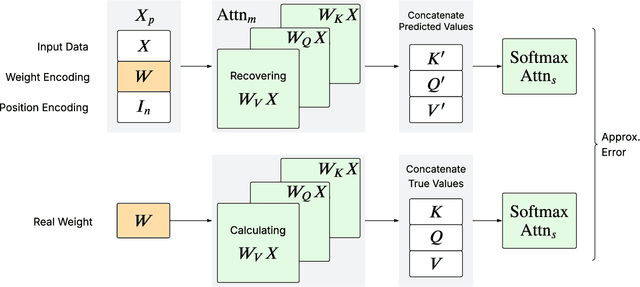

Abstract:We prove that a minimal Transformer architecture with frozen weights is capable of emulating a broad class of algorithms by in-context prompting. In particular, for any algorithm implementable by a fixed-weight attention head (e.g. one-step gradient descent or linear/ridge regression), there exists a prompt that drives a two-layer softmax attention module to reproduce the algorithm's output with arbitrary precision. This guarantee extends even to a single-head attention layer (using longer prompts if necessary), achieving architectural minimality. Our key idea is to construct prompts that encode an algorithm's parameters into token representations, creating sharp dot-product gaps that force the softmax attention to follow the intended computation. This construction requires no feed-forward layers and no parameter updates. All adaptation happens through the prompt alone. These findings forge a direct link between in-context learning and algorithmic emulation, and offer a simple mechanism for large Transformers to serve as prompt-programmable libraries of algorithms. They illuminate how GPT-style foundation models may swap algorithms via prompts alone, establishing a form of algorithmic universality in modern Transformer models.
Evo-MARL: Co-Evolutionary Multi-Agent Reinforcement Learning for Internalized Safety
Aug 05, 2025


Abstract:Multi-agent systems (MAS) built on multimodal large language models exhibit strong collaboration and performance. However, their growing openness and interaction complexity pose serious risks, notably jailbreak and adversarial attacks. Existing defenses typically rely on external guard modules, such as dedicated safety agents, to handle unsafe behaviors. Unfortunately, this paradigm faces two challenges: (1) standalone agents offer limited protection, and (2) their independence leads to single-point failure-if compromised, system-wide safety collapses. Naively increasing the number of guard agents further raises cost and complexity. To address these challenges, we propose Evo-MARL, a novel multi-agent reinforcement learning (MARL) framework that enables all task agents to jointly acquire defensive capabilities. Rather than relying on external safety modules, Evo-MARL trains each agent to simultaneously perform its primary function and resist adversarial threats, ensuring robustness without increasing system overhead or single-node failure. Furthermore, Evo-MARL integrates evolutionary search with parameter-sharing reinforcement learning to co-evolve attackers and defenders. This adversarial training paradigm internalizes safety mechanisms and continually enhances MAS performance under co-evolving threats. Experiments show that Evo-MARL reduces attack success rates by up to 22% while boosting accuracy by up to 5% on reasoning tasks-demonstrating that safety and utility can be jointly improved.
Spatial Mental Modeling from Limited Views
Jun 26, 2025



Abstract:Can Vision Language Models (VLMs) imagine the full scene from just a few views, like humans do? Humans form spatial mental models, internal representations of unseen space, to reason about layout, perspective, and motion. Our new MindCube benchmark with 21,154 questions across 3,268 images exposes this critical gap, where existing VLMs exhibit near-random performance. Using MindCube, we systematically evaluate how well VLMs build robust spatial mental models through representing positions (cognitive mapping), orientations (perspective-taking), and dynamics (mental simulation for "what-if" movements). We then explore three approaches to help VLMs approximate spatial mental models, including unseen intermediate views, natural language reasoning chains, and cognitive maps. The significant improvement comes from a synergistic approach, "map-then-reason", that jointly trains the model to first generate a cognitive map and then reason upon it. By training models to reason over these internal maps, we boosted accuracy from 37.8% to 60.8% (+23.0%). Adding reinforcement learning pushed performance even further to 70.7% (+32.9%). Our key insight is that such scaffolding of spatial mental models, actively constructing and utilizing internal structured spatial representations with flexible reasoning processes, significantly improves understanding of unobservable space.
KEPLA: A Knowledge-Enhanced Deep Learning Framework for Accurate Protein-Ligand Binding Affinity Prediction
Jun 16, 2025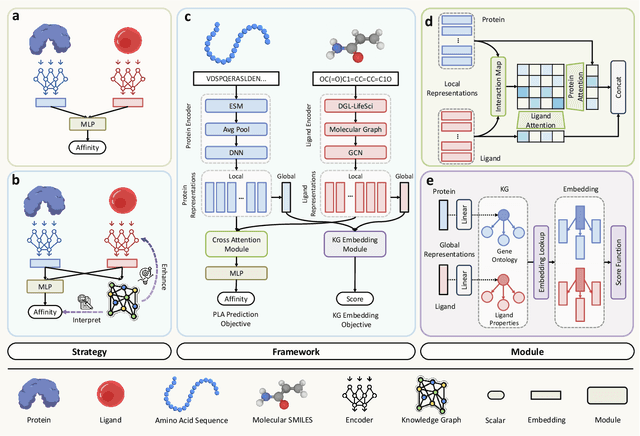
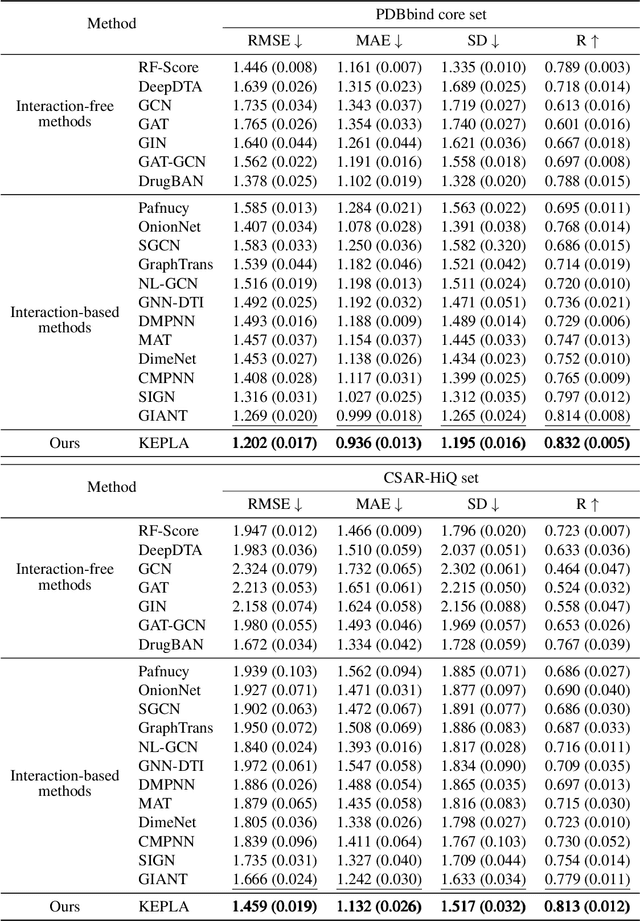
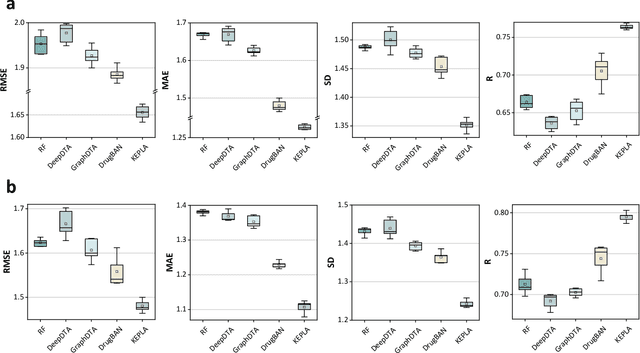
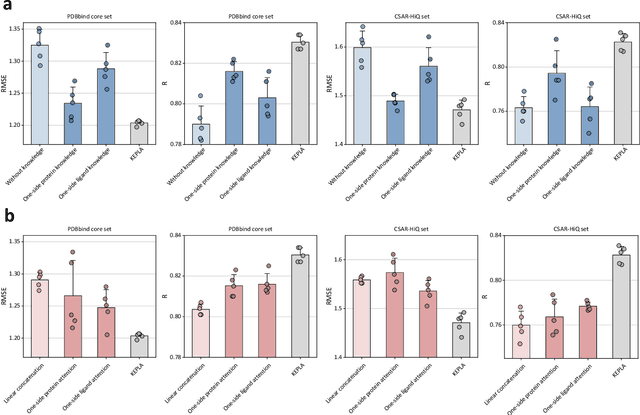
Abstract:Accurate prediction of protein-ligand binding affinity is critical for drug discovery. While recent deep learning approaches have demonstrated promising results, they often rely solely on structural features, overlooking valuable biochemical knowledge associated with binding affinity. To address this limitation, we propose KEPLA, a novel deep learning framework that explicitly integrates prior knowledge from Gene Ontology and ligand properties of proteins and ligands to enhance prediction performance. KEPLA takes protein sequences and ligand molecular graphs as input and optimizes two complementary objectives: (1) aligning global representations with knowledge graph relations to capture domain-specific biochemical insights, and (2) leveraging cross attention between local representations to construct fine-grained joint embeddings for prediction. Experiments on two benchmark datasets across both in-domain and cross-domain scenarios demonstrate that KEPLA consistently outperforms state-of-the-art baselines. Furthermore, interpretability analyses based on knowledge graph relations and cross attention maps provide valuable insights into the underlying predictive mechanisms.
 Add to Chrome
Add to Chrome Add to Firefox
Add to Firefox Add to Edge
Add to Edge